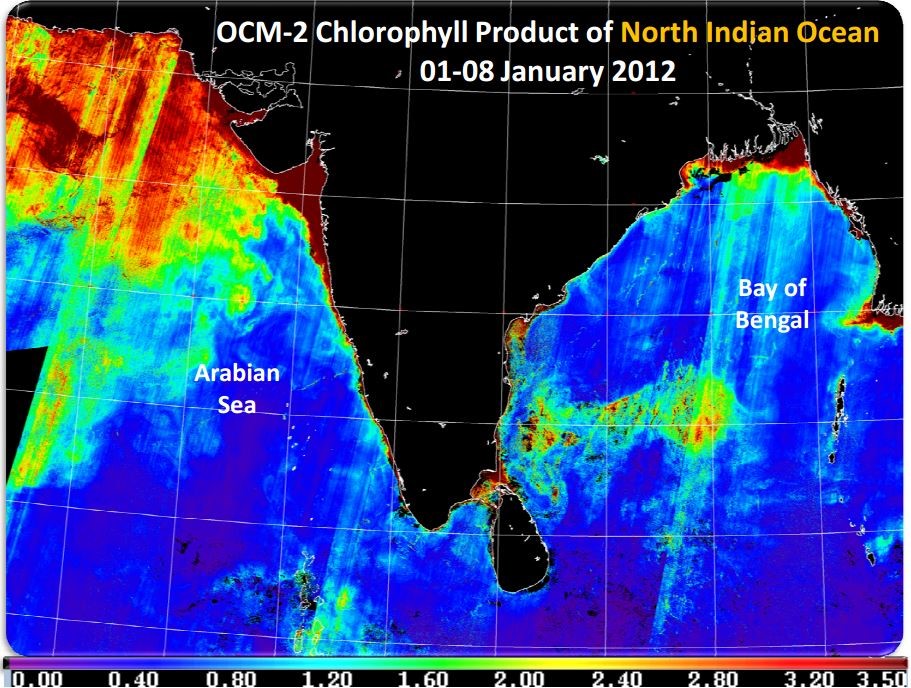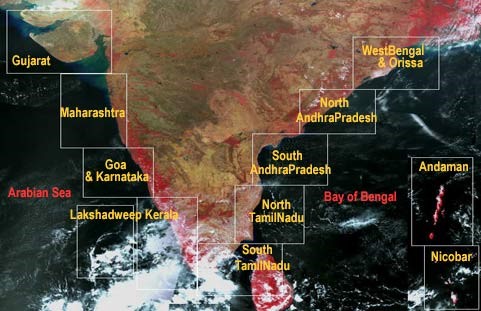Coastal Ocean Sensing and Forecasting for Fisheries Management:
Practical Systems for India
|
P.F.J. Lermusiaux, P.J. Haley, Jr., D. Subramani Massachusetts Institute of Technology
|
Project Summary Ongoing MIT-MSEAS Research TATA-supported Publications Additional Project Links Background Information References
|

|

|
| This research is sponsored by the MIT Tata Center. | |||
Project Summary
This project aims to develop and provide ocean physical and biogeochemical forecasting products and technologies for coastal fisheries management in India. Our modeling systems provide ocean field and uncertainty estimates, optimal sensing guidance, coastal ecosystem-based scenario analyses, and technical decision aides. We plan to build practical systems and products that are tailored to the Indian context and usable for local commercial and societal applications involving fisheries but also coastal zone management, monitoring, ocean engineering, financial hedging, and re-insurance. In addition to educating students, we also collaborate with colleagues from UMass (Prof. Avijit Gangopadhyay) and WHOI (Dr. Glen Gawarkiewicz), as well as with IITs, local agencies and fishermen organizations.
Background information is available below.
| Top of page |
Ongoing MIT-MSEAS Research
Long-Term Goals:
- Further develop our new uncertainity quantification and data assimilation schemes for regional ocean modeling and forecasting.
- Apply our theory and schemes for providing ocean physical and biogeochemical forecasting products for coastal fisheries management in India.
Objectives:
The primary goal of our effort is to develop and provide ocean physical and bio-geo-chemical forecasting products and technologies for coastal fisheries management in India. Our specific objectives are to:
- set-up our modeling systems for the north Bengal and the Arabian Sea regions providing field and uncertainty estimates, optimal sensing network guidance, coastal ecosystem-based scenario analyses, and technical decision aides;
- build practical systems and products that are tailored to the Indian context and usable for local commercial and societal applications involving fisheries but also coastal zone management, monitoring, ocean engineering, financial hedging, and re-insurance; and
- educate students and collaborate with IITs, local agencies and fishermen organizations.
Presentations and Meetings
- Meeting with partners and collaborators from MIT, UMass, and IIT Bhubaneswar at IIT Bhubaneswar on August 6, 2015
- Talk at IIT Bhubaneswar on August 6, 2015
- Meeting with Shri. Prakash Javadekar, Honarable Minister of State for Environment, Forests and Climate Change, Govt. of India on April 6, 2015
MSEAS Fisheries Simulations for Lakshadweep Region (December 2018)
| Top of page |
Additional Project Links
| Top of page |
Background Information
In India, the coastal ocean provides multiple means of sustainable development. It affects many economic sectors including coastal management, fisheries, energy, tourism, conservation, shipping, security and marine operations. It is also essential to welfare, linking to climate regulation, carbon sequestration, habitat and biodiversity. The inland water resources and the coastal Indian oceans provide employment to more than 14 million people in the fisheries sectors alone. To successfully coexist with the ocean and optimally utilize and manage marine resources, India needs to monitor and predict impacts of ocean activities, and to operate efficient coastal sensing technologies. Better understanding and forecasting of environmental resources and human impacts requires novel synergies between sensing and modeling. Such innovations will lead to better ocean management. All of this is especially crucial for India. However, solutions must be suited to the Indian context. Systems should be practical, integrated with local organizations and populations, and geared towards the specifics of the Indian coastal zones, ecosystem, and livelihoods.
Increased demand for fish, coupled with unsustainable fishing practices lead to over-exploitation and fast depletion of fish stocks. Coastal fisheries and aquaculture stocks often thrive on very specific water conditions. Building capabilities for coastal ecosystem forecasting and for optimal ocean data collection will help in ensuring and managing the survival and reproduction of healthy stock. This is another motivation for our work.
- Multiscale regional dynamics and process modeling (e.g., what are key dynamics and exchanges occurring in the region among the mixed-layer dynamics, boundary currents and/or subsurface circulation features), and
- Multi-resolution modeling and data assimilation (e.g., what is the optimal way to utilize the information content collected by the new Bay of Bengal Coastal Observation System?), and
- Species-specific fish forecast (e.g., how to utilize and tune existing temperature-food model to provide species specific forecast of Bhetki, Pomphret, Hilsa and Mackarel?).
| Top of page |
References
- Haley, P.J., Jr. and P.F.J. Lermusiaux, 2010. Multiscale two-way embedding schemes for free-surface primitive-equations in the Multidisciplinary Simulation, Estimation and Assimilation System. Ocean Dynamics, 60, 1497-1537. doi:10.1007/s10236-010-0349-4.

- Haley, P.J., Jr., A. Agarwal, P.F.J. Lermusiaux, 2015. Optimizing Velocities and Transports for Complex Coastal Regions and Archipelagos. Ocean Modeling, 89, 1-28. doi:10.1016/j.ocemod.2015.02.005

- Lermusiaux, P.F.J, 2007. Adaptive Modeling, Adaptive Data Assimilation and Adaptive Sampling. Refereed invited manuscript. Special issue on "Mathematical Issues and Challenges in Data Assimilation for Geophysical Systems: Interdisciplinary Perspectives". C.K.R.T. Jones and K. Ide, Eds. Physica D, Vol 230, 172-196, doi:
10.1016/j.physd.2007.02.014.

- Lermusiaux, P.F.J., J. Schröter, S. Danilov, M. Iskandarani, N. Pinardi and J.J. Westerink, 2013. Multiscale Modeling of Coastal, Shelf and Global Ocean Dynamics, Ocean Dynamics. 63:1341–1344. DOI: 10.1007/s10236-013-0655-8

- Sondergaard, T. and P.F.J. Lermusiaux, 2013b. Data Assimilation with Gaussian Mixture Models using the Dynamically Orthogonal Field Equations. Part II: Applications. Monthly Weather Review, 141, 6, 1761-1785, doi:10.1175/MWR-D-11-00296.1.

- Sondergaard, T. and P.F.J. Lermusiaux, 2013a. Data Assimilation with Gaussian Mixture Models using the Dynamically Orthogonal
Field Equations. Part I. Theory and Scheme. Monthly Weather Review, 141, 6, 1737-1760, doi:10.1175/MWR-D-11-00295.1.

-
Ueckermann, M.P., P.F.J. Lermusiaux and T.P. Sapsis, 2013. Numerical Schemes for Dynamically Orthogonal Equations of Stochastic Fluid and Ocean Flows. J. Comp. Phys., 233, 272-294, doi: 10.1016/j.jcp.2012.08.041.

- Rixen, M., P.F.J. Lermusiaux and J. Osler, 2012. Quantifying, Predicting and Exploiting Uncertainties in Marine Environments, Ocean Dynamics, 62(3):495–499, doi: 10.1007/s10236-012-0526-8.

- Map of fishing zone source: INCOIS
- Chlorophyll map source: Oceanographic Division, National Remote Sensing Center (ISRO)
| Top of page |



